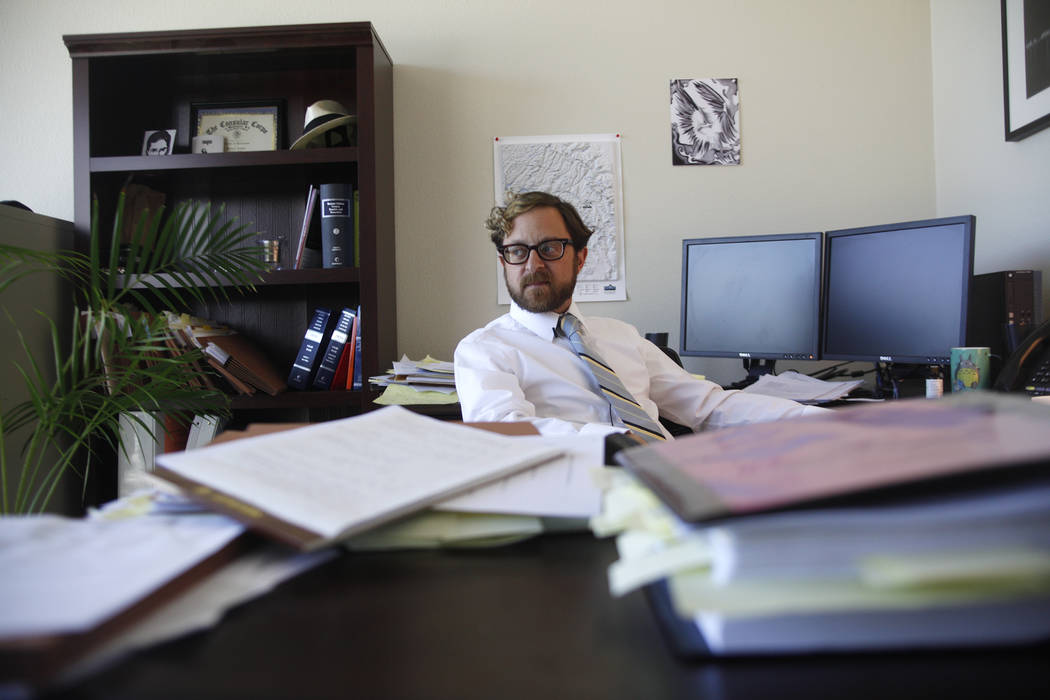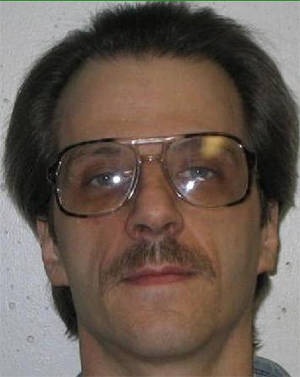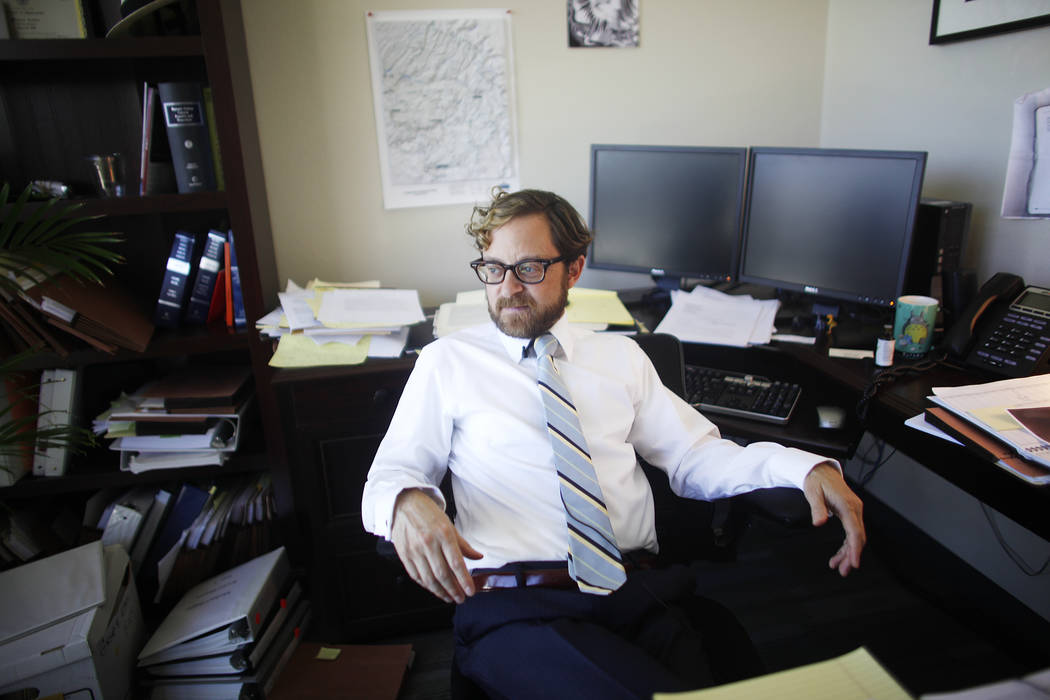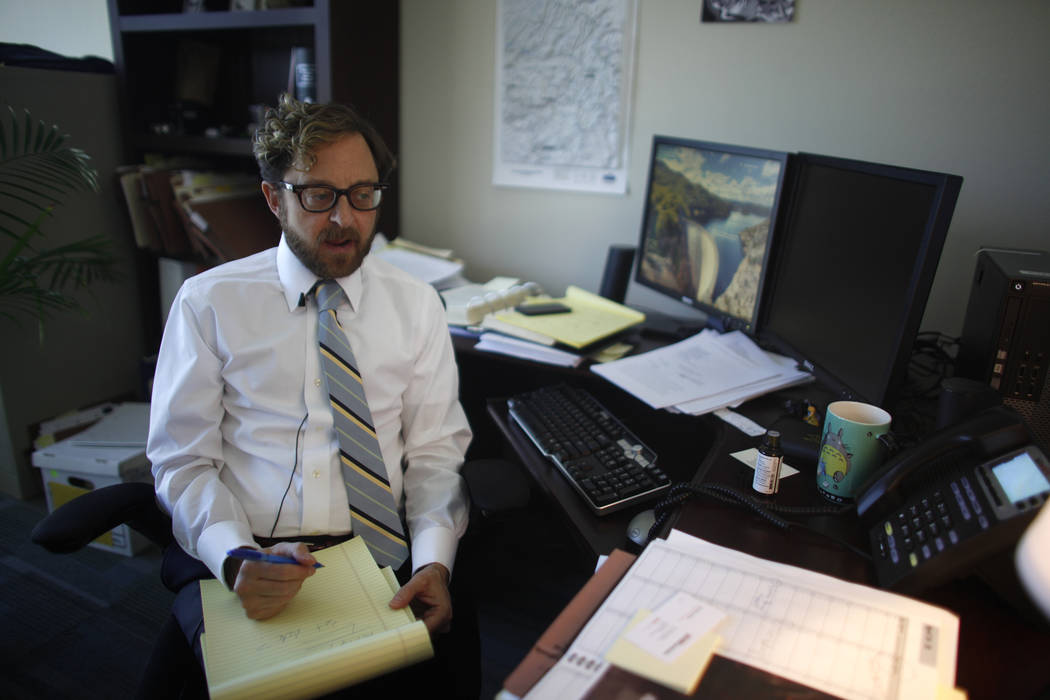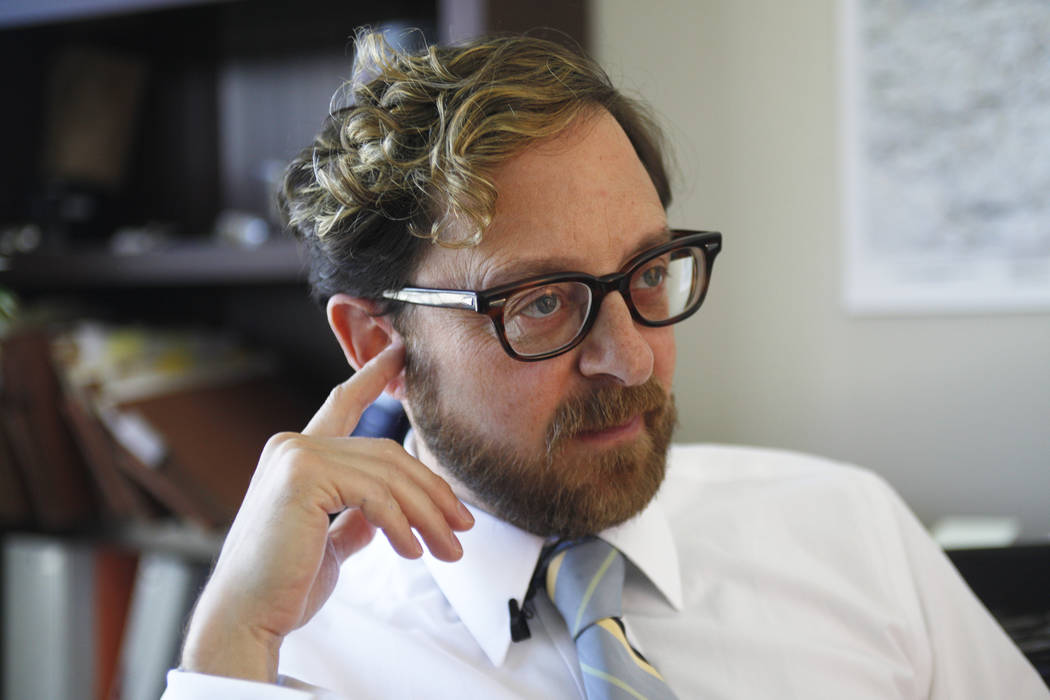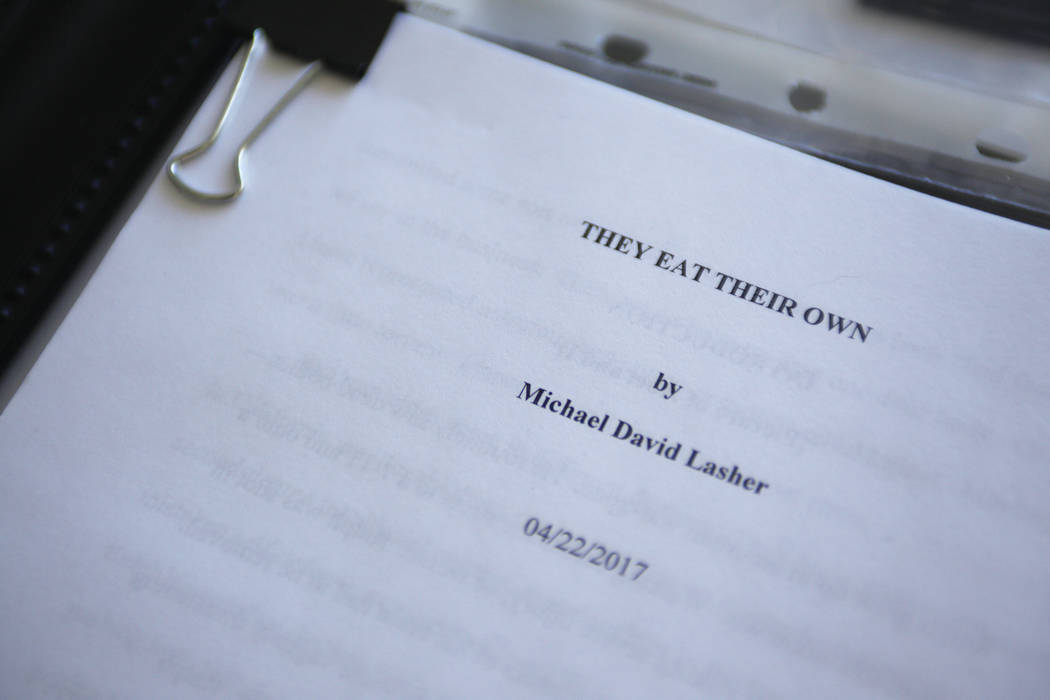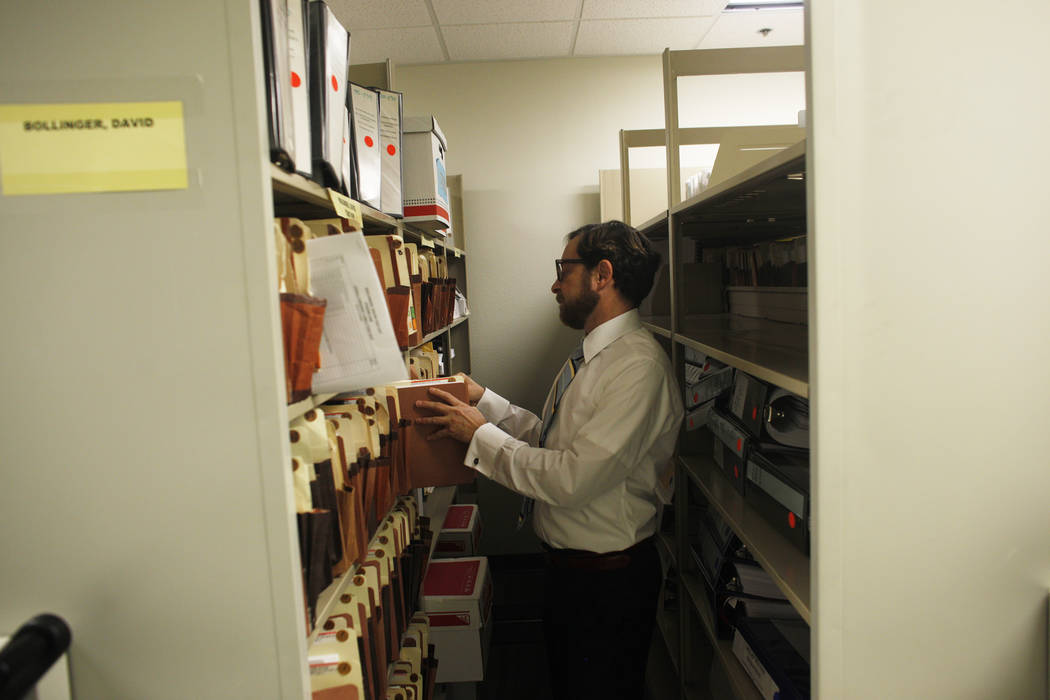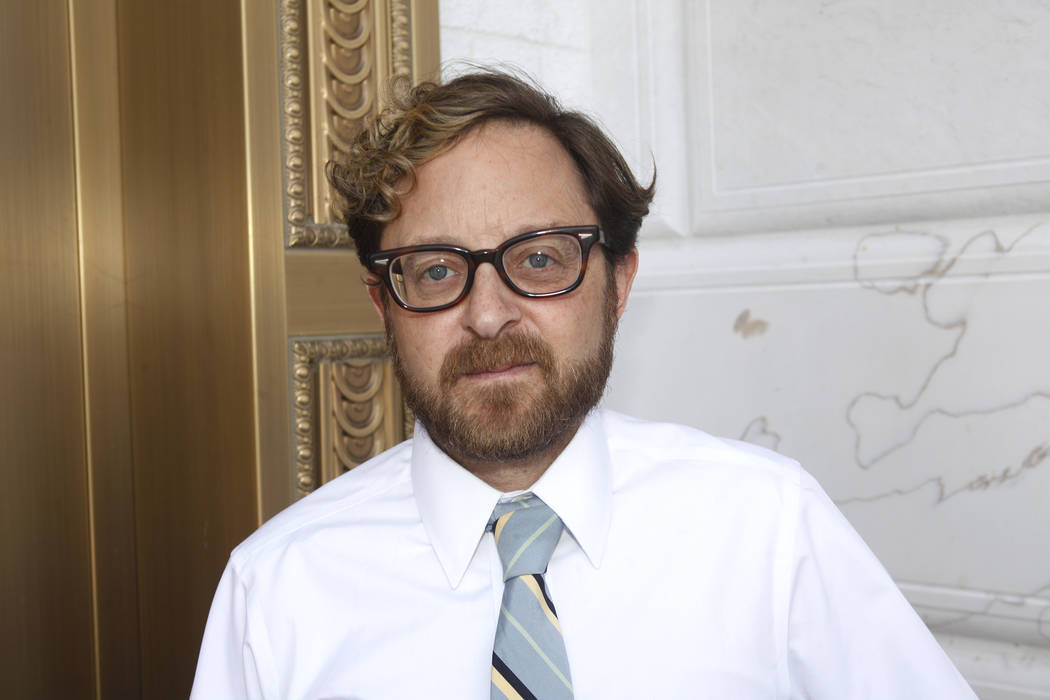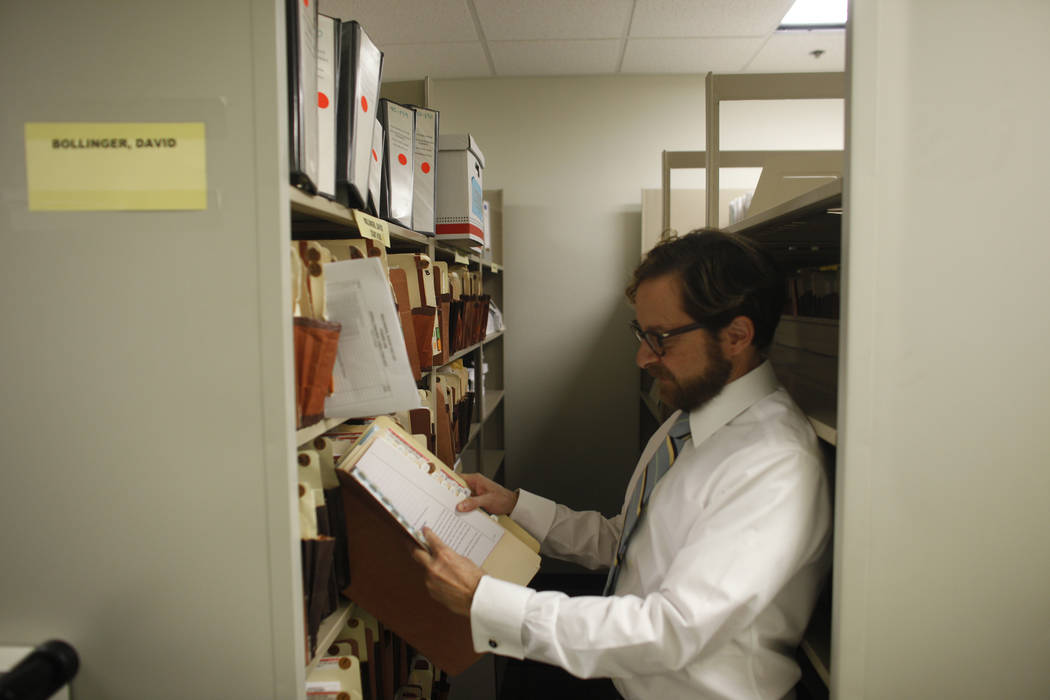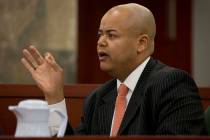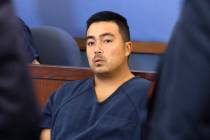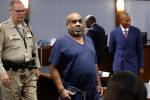Attorney pens book on experiences representing death row inmates
Defense attorney Michael Lasher answers his phone. There’s a convicted killer on the line.
David Bollinger is housed on death row inside the Ely State Prison, where he has spent 23 years for the murder of an elderly Reno couple. The jury found the former temporary worker had kidnapped and killed James and Rose Vertres in 1992, setting their bodies on fire.
Now Bollinger languishes inside a small solitary cell, awaiting his turn to die.
He dials Lasher from a pay phone not 60 feet from his medieval lockup. Dressed in his prison blues, he stares straight ahead at a cinder-block wall during a rare bit of contact with the outside world.
Lasher is Bollinger’s lawyer. At age 50, he’s a slight man with boyish, oversized glasses and curly red hair. He resembles a young Buddy Holly or Woody Allen, a teen still awaiting his growth spurt, but with the emotional scars of somebody who’s been around.
The veteran capital punishment defense attorney took on Bollinger’s case after moving to Las Vegas in 2015 as a new member of the federal government’s public defender’s team. He took the call inside his cluttered downtown office, whose passageways reek from the decay of case files that line the walls.
These phone meetings are haphazard. Frequent prison lockdowns triggered by inmate violence means Lasher can wait for calls that never come. More often, Bollinger and Lasher rely on rudimentary “kites” traded through the prison communication system.
“Hey, David,” he says informally, as though greeting a fellow lawyer, or a drinking buddy.
They discuss Bollinger’s appeal for a retrial that cites judicial bias based on the public defender’s alleged conflict of interest. The lawyer says he took a rare Sunday off the day before, a break from the relentless grind of the appeal. Bollinger is glad.
Lasher knows what he faces. The case contains “bad facts,” including that the couple’s bodies were found in flames inside a dumpster. Still, thanks to his research, he sees questions unanswered and issues unresolved.
Bollinger maintains his innocence. Evidence suggests Vertres may have killed his ex-wife, who had divorced him while he was in jail for harassing a prostitute with a weapon. Vertres had often brought home hookers while his wife was at work, the investigation showed. The wife had been beaten by her husband and contemplated running away.
Now Lasher seeks a second day in court for his client — as he seeks his own salvation.
Insights and infamy
Lasher is turning his legal experiences into literature. He’s writing a memoir that’s largely confessional, exploring how his work with convicted killers has triggered his own existential doubts.
The book’s title, “They Eat Their Own,” is not a reference to the incarcerated but to the lawyers who represent them; a legal clan from which Lasher has for years desperately sought acceptance. He calls them The Tribe, a deeply flawed collection of “do-gooder twits, death penalty abolitionists and street fighters,” lawyers often wrongly accused of “fighting dirty on behalf of murderers.”
Lasher’s work is a delicate legal and emotional dance. As he fights for society’s damned and depraved, he confronts his own inadequacies. Despite 25 years as a lawyer — 17 trying capital cases — the sheer complexity of the appeals, public prejudice against convicted killers and his own fear of failure conspire against him.
Knowing that hundreds of convicted killers have already been exonerated nationwide creates a strange pressure. It makes him question his grit and tactics, makes him feel as clumsy as a dirt farmer performing a finely timed waltz.
Late at night, nursing a rye Manhattan inside his downtown home, he admits he’s as emotionally broken as the condemned men he visits — someone who seeks refuge in risk-taking and self-loathing, convicted killers and troubled relationships.
As a child, Lasher suffered an overbearing father who undercut his self-esteem. He later sought out doomed relationships with damaged women. He’s a pain junkie whose dogged work ethic disguises his perceived weaknesses. He’s a man still trying to keep his impulses in check. In some ways, he believes, he too is condemned.
Digging deep
Like the denizens of death row, Lasher has made bad choices.
“By the grace of God I didn’t end up in their place — as regular folks with a raw end in life,” he said. “I’ve had my share of heightened moments of emotion where things could have gone very badly. But they didn’t. That’s why I’m still on the outside representing the men who are in there.”
Along with his work as an attorney, Lasher has also spent years as an investigator, exploring the backgrounds of his death row clients. He has traveled the world, seeking insights into their violent behavior, hoping to uncover new facts or an unreported witness account that might reduce a death penalty to life in prison. He once traveled to South Korea in search of a condemned man’s hard-to-find birth mother to learn about his difficult childhood.
Lasher is unique in this respect; few lawyers do their own digging. Most don’t want to sit on a stained couch, “worrying about getting fleas,” he wrote in his manuscript. “They don’t want to watch a witness sob for three hours and then be hit up for forty bucks.”
His work has led him to rifle through fetid garbage cans, “using a stick to paw soiled clothing.” On a stakeout, he wolfed down Chinese food with his hands. He ventured into a biker’s bar seeking an elusive witness, a tough guy who resembled a “fat overripe tomato” with dirty blond hair, stuffed into a black leather jacket.
There have been moments of Fellini-like farce. Once, as Lasher interviewed a witness in his home, a caged parrot began chirping in Spanish and English. A pair of dwarfs then appeared to poke him in the ribs.
In chapters like “How to find those creeps who don’t want to be found” and “The death charm offensive: how to push your real feelings down into your gut for a good interview,” he shows how to scour leads from criminal court files and facts found in car registration, bankruptcy, sex-offender and hunting-license records. He corners sketchy characters and sometimes elicits answers once he finds them.
He tells of getting a “scared pensioner to unchain the door, let you in, and talk about things like living in South Central’s war zone,” about getting “a reticent family to reveal painful, embarrassing secret beatings and alcoholism and incest,” and shows “how to poke around in a rough neighborhood without getting jumped.”
Lasher observes strangers closely, like a social worker. “Some folks are really poor, living in squalid deep woods trailers with pirated electricity or violent housing projects with their own subterranean societies. Some live in banal suburbs, which bum me out more than a sand-blasted house in the middle of an empty block in the high desert.”
Lasher trusts no one; not judges, prosecutors, lazy defense lawyers and public defenders, witnesses, or even some of his hundreds of clients. As an investigator, he pursues not whodunits, but “why-dunits” — crimes involving torture, shuddering violence and multiple victims. Innocence, he says, isn’t the issue in most of his cases.
Still, Lasher believes in redemption. His clients may have done reprehensible things, but he does not see them as reprehensible people.
‘Putting it out there’
Investigator Dave Presson has known Lasher for 20 years. “I knew he was an outcast, so I didn’t think anything would surprise me.”
Then he read the manuscript.
“He’s really putting it out there,” he said. “It’s vulnerable and it’s raw.”
A few years ago, Lasher decided to write the tell-all memoir, to take readers down a psychological rabbit hole into the realm of capital crime.
There were colorful personalities, including the three female bank robbers who complained how their male counterparts got all the glory, and the Mafia money collector “whose every sentence is shouted inches from my face, spit obscuring my glasses.”
He wrote on nights and weekends, producing pages that tracked his evolution from a novice Northern California public defender to delving into the psyches of killers.
They included a schizophrenic white supremacist who murdered a hairdresser and a plastic surgeon, because he thought they promoted false Aryan vanity people did not deserve; Richard Allen Davis, who raped and murdered 12-year-old Polly Klaas in California, and a drifter who killed a university police officer with a hatchet.
Early in his career, Lasher thought he wanted to become an environmental attorney. He had graduated from the University of California at Berkeley and the Hastings School of Law in San Francisco. One summer, he scored an internship in the federal public defender’s office, representing drunks, brawlers and thieves in Yosemite National Park.
He litigated before the cantankerous Federal Judge Donald Pitts, a bearded, long-haired, former smoke jumper with an affinity for bolo ties, colorful vests and a 160-pound Rottweiler named Bailiff, who accompanied him to court.
“I was hooked,” Lasher said.
For 12 years, he worked for the California Appellate Court Project, defending death row inmates housed at the infamous San Quentin prison. He later took a Washington desk job for a group seeking adequate resources for condemned killers. But he missed the trenches — working one-on-one with men facing death. He moved to Las Vegas in 2015 to rejoin the fight.
‘Win-at-all-cost mentality’
By then, Lasher was well into his book, in which he argued the injustice of capital punishment. He wrote of how race plays a role, with blacks being executed at a much higher rate than whites, how faulty witnesses and prosecutors withholding crucial evidence have unfairly rendered men to their deaths.
“Capital punishment brings out people’s worst behavior,” he said. “Cops, prosecutors and judges want convictions … Justice tends to be greater for convicted killers. Prosecutors justify their means, saying, ‘If this guy didn’t do this one, he did others.’ It’s a win-at-all-costs mentality.”
In his writing, Lasher found he couldn’t detail his work without also revealing himself.
“The book became an exorcism of the things I’ve witnessed,” he said. “It’s also a way to process some of my own demons – similar to a 12-Step program.”
He asked himself hard questions: “Why was I trying to save the condemned?” and “Why was I driven to protect mostly nasty broken people?”
As a boy, Lasher had stood up for the underdog. But something happened, twisted experiences that turned him into a trauma junkie, who focused on the pain of others to avoid his own issues.
He was a timid boy who gently assuaged his nuclear-physicist father’s mercurial moods, when he threw insults and oil-smeared work rags inside the family’s Los Angeles home. Lasher was later bullied at school. Maybe his trauma does not reach the level of his condemned clients, but it is there nonetheless.
For years, Lasher also sought out distant, damaged women — a cocaine addict, narcissist and survivors of sexual assault. He convinced himself that “if I try really, really hard, and do the dishes and make money and hang on her every flicker of emotion, maybe, just maybe, she will like me.”
Strangely, his co-dependency made him a better investigator. He didn’t judge the people he interviewed, not on the outside anyway.
“The witness kicks his dog? Not a peep from me, even though I’m raging inside,” he wrote. “ … A measure of both my skill and depravity, reviled witnesses never know of my disgust and ire, buried as they are under my drive to build a client’s case, under my personal and occupational need for approval.”
The Tribe
He also questioned the hyper-critical death-row defense community he calls The Tribe. “They can be mean,” he wrote. “Maybe the stress of the work turns us against each other. And maybe the work attracts bent people, myself included. People who want to save reviled killers, destroyers of society.”
But Presson believes that Lasher stands out from his own tribe of death row lawyers. “People gravitate to professions and roles that fit their personality,” he said. “But other members of the tribe just don’t have the level of consciousness that Lasher does.”
Lasher’s own flawed past is a passport into the daily terror in which his condemned clients grew up; belittled, beaten with an extension cord or a skillet.
The stepmother of one killer tied him to a bed naked; his father made him eat out of a dog bowl as punishment. Lasher once photographed the pole to which his client was tied in his basement.
Even the trauma junkie had seen enough.
“Another basement of horror and fear,” he wrote. “How many god-——— scary basements will my career hold?”
In the end, Lasher refrains from judgment – of himself and his community of killers, those men he views as flawed, but still human.
He describes one client as “large ruddy-cheeked, inarticulate, generous, kind and prone to weeping in the visiting cage at San Quentin.”
He admits he only knows the current version of the man, not his drug-use years. “He was probably a mean jerk then, judging by his crazed mug shot,” he wrote. “Fixed stare, wild hair, mouth a rictus of anger.”
He talks of another killer who has his personal phone number, whom he greets with an obligatory hug. Once, Lasher took his grown daughter to visit the onetime bank robber, who now resembles a grandfather with his graying beard and wire-frame glasses.
The condemned man took time to advise the young woman on choices not to make.
Lasher sees redemption in that.
Trust and thanks
David Bollinger doesn’t want to die; not now, not like this — strapped to a gurney and force-fed poison. There’s little joy in his life as he awaits his date.
But there is this: He trusts his lawyer.
He and Lasher discuss the progress on their appeal. “I spent the weekend psyching myself up,” Bollinger confides. But his emotions are runaway. In response to Lasher’s optimism, he responds, “We shall see. I’m trying not to get overly excited about it.”
He thanks the lawyer for his dogged belief they can win. “He’s willing to go out of his way to investigate the facts of the case,” Bollinger said.
Twenty years ago, Bollinger spent a night in the holding cell next to the Ely prison’s death chamber. He doesn’t want to go back.
He struggles to describe what the experience felt like. “Even the question is difficult to contemplate,” he says. “I really can’t define it in my own mind.”
As he talks, Lasher listens, tipped back in his chair — a now less-broken man contemplating the plight of broken people.
Award-winning journalist John M. Glionna, a former Los Angeles Times staff writer, may be reached at john.glionna@gmail.com. Follow @jgionna on Twitter.



